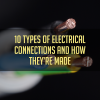Heat Shrink Tubing: Why and How We Use It

Since the 1950s, heat shrink tubing has provided an extra layer of support to the wiring and cables found in automotives, factories, homes and just about everywhere else you may find a wire or a cable. It continues to be utilized around the world to help ensure the longevity and ease of organization for whatever your wiring needs may be. Find out more about the history of heat shrink tubing, pvc tubing and shrink wrap tubing, its uses, and the details of what makes it a crucial component to the health and durability of wires.
What is heat shrink tubing?
Heat shrink tubing (also called heat shrink sleeving) is a hollow, polymer tube that contracts when heated. Heat shrink tubing was developed in the late 1950s by Paul Cook of the Raychem Corporation.
The amount at which the tubing shrinks depends on the material, diameter, and temperature used to apply it. It is typically used in projects that contain a complex webbing of wires or cables to ensure that the wires are insulated and protected from external forces like water damage or shocks.
Heatshrink tubing can be found just about anywhere that there are cables or wires. Not only is it applied for protection, but it also provides cosmetic enhancement by helping to color code and/or bundle wires. Heat shrink tubing can be wrapped around an individual wire, a connection between two wires or several wires. As the tube is heated, it shrinks, tightening around the wire.
The process to heat shrink tubing is very simple. The amount of heat that needs to be applied to shrink the tubing can vary depending on parameters like material, size and shrink ratio. Isolated heat is provided through a heat gun which directs these varying temperatures directly on the tubing.
Why do we use heat shrink tubing?
Heat shrink tubing is essential in improving the protection, lifetime, and maintenance of wires in a circuit. It is great for securing connections, avoiding tangling with wires, and insulating against shocks or short-circuits.
Heat shrink tubing, first and foremost, is used to protect wires and cables from a multitude of external sources like abrasion, cutting, scuffing or other low impact instances. It can also protect wires from oil, water, acids, humidity and temperature. Heat shrink tubing is specially designed to be used in harsh environments, withstanding temperatures from -65°C to +260°C.
Another important use for heat shrink tubing is rust protection for hardware like metal piping and welded joints. When welding stainless steel tubes, the insulation coating might become depleted due to heat. Unlike the insulation coating, certain types of heat shrink tubing are built with a second layer to act as insulation once heated. They then merge perfectly to the metal surface to protect the pipelines from rust.
Heat shrink tubing can also be used to bundle cables. Wires can get annoying, and even more so when using a hefty electrical system. Heat shrink tubing can allow you to bundle wires together within a single tube. This is great for managing wires but also decreasing the bulk and messiness that multiple wires can lead to.
Some other common uses for heat shrink tubing are:
- Sealing water and dust out of cable splices
- Insulating cables and wires against extreme heat in aircraft, boats, and military vehicles
- Providing a barrier between cables and corrosive chemicals
- Color coding cables for easy identification
- Make long-lasting labels for network patch cords
- Neatly terminating the ends of braided sleeving
- Improving the look of cables in computer case mods or custom cars and motorcycles
Everyday wear and tear on wires and cables is usually caused by lack of space or length thus affecting the lifespan of a wire. Heat shrink can be used to reduce the strain applied to wires by adding another layer of durability.1
Considerations when purchasing heat shrink tubing
Before you purchase your own heat shrink tubing you have to understand the needs of your application first and foremost. What the heat shrink tubing will be used for will implicate the type of tubing you buy. There are a variety of different types of heat shrink tubing that vary based on material, shrink ratio, inner diameter size, length and thickness.
Material
Heat shrink tubing can be made of a variety of different materials, the most common being polyolefin, fabric, polyvinyl chloride (PVC) and polytetrafluoroethylene (teflon).
Polyolefin is the most common material used for heat shrink tubing. It is flexible, fast shrinking, has excellent durability, high flame and UV resistance. It has a shrinking temperature of 120°C and withstands a high temperature of 125°C - 135°C. It is mostly used for mechanical protection, insulation and marking.
Fabric heat shrink is a woven blend of polyolefin and polyester. It is highly flexible while still being able to retain strength and abrasion resistance. Unlike polyolefin and PVC, it has a lower shrink temperature of 80°C. It also shrinks more lengthwise than other types of heat shrink tubing.
In comparison to polyolefin, PVC heat shrink costs less, but cannot withstand the same high temperatures making it good for food, drink or exposed applications. Although it is particularly heat sensitive, PVC heat shrink has better tensile strength and abrasion resistance.
Teflon heat shrink on the other hand, is used in circumstances that require a high-temperature operation. It is mostly used in industrial settings versus standard applications.
If you would like to know more about the types of heat shrink tubing available and their detailed specifications check out this article, on Types of Heat Shrink.
Shrink Ratio
Heat shrink tubing comes labelled with a shrink ratio, a measurement of how small the tubing will get when heated. Most heat shrink tubing has a 2:1 ratio, in which the diameter of the heat shrink will decrease in size by 50%. Other common ratios for heat shrink are 3:1, 4:1, and 6:1.
Other considerations
In most scenarios, heat shrink tubing will be reduced lengthwise between 5-7%, so when purchasing it is important to get tubing that is longer than needed to adjust for this shrinkage.
Diameter is also another important consideration. For the best coverage, you should allow for 20-30% extra inner diameter to ensure the appropriate space for the heat shrink tubing to be able to merge along with the wiring tightly.
How does it shrink?
In most cases, plastic doesn't shrink. What makes heat shrink tubing special is a process called cross-linking. Cross-linking is the process of exposing a polymer to radiation in order to create covalent bonds between the polymer’s atoms thus condensing their size. This process was discovered after World War II; that radiation could alter the molecular structure of certain plastics so that they wouldn't melt or develop flowing consistency. Covalent bonds also give polymers plastic memory, this means that once a polymer has gone through the cross-linking process and in this case stretched into an expanded shape (like over a pipe), it will automatically shrink back to its original dimensions when a certain amount of heat is applied.
Heat shrink tubing is an essential component to address your wiring and cable needs. When it comes to picking the heat shrink tubing that is right for you, it is important to understand the why and how to ensure you make an informed decision.
Want to know more about Heat Shrink?
Hopefully, this guide has helped you understand all you need to know to choose the best type of heat shrink tubing for your application. Set up an account or log in to put in an order.
If you have additional questions, visit our learning center or FAQs. Or you can contact us here with questions or to receive a sample.














